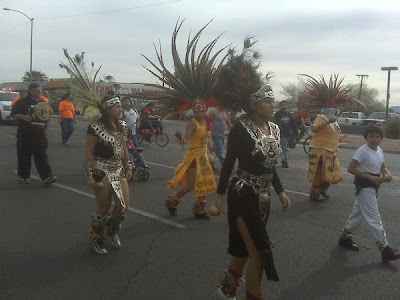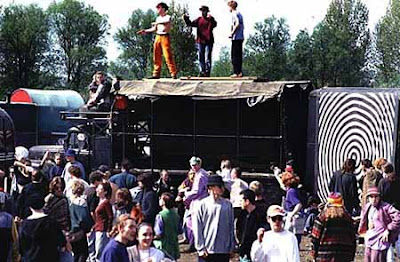'Circus jugglers pelted police with crockery when their fireworks party went off with too much of a bang. Officers were called to break up the bash after neighbours complained of the noise. But when they arrived, the Big Top revellers bombarded them with a hail of plates and cups. Thirteen people were arreseted and nine officers hurt.
Circus performers from all over Europe were at the party in Brixton, South London, to say farewell to a colleague. In bizarre private shows, a fire-eater wolfed down flames in the back garden and jugglers showed off their skills. But when the music carried on until the early hours, accompanied by fireworks going off, neighbours dialled the law.
A PC who turned up was half dragged inside, then had the door slammed in his face. Reinforcements rushed to the scene – and crockery, sticks and stones rained down from upstairs windows. One party goer said: ‘People panicked when the police turned up’. Officers eventually forced their way in through the back door and arrested all those inside. The injured officers suffered cuts and bruises. But none needed hospital attention'.
Eight cops injured by Circus Revellers (South London Press 21 May 1993):
'Police officers were pelted with plates, cups, and sticks, after being called to break up a wild party of circus performers. Eight officers needed treatment to minor injuries following a fracas at the squat in Arlingford Road, Brixton, early on Wednesday. The revellers, many German and French, were celebrating the departure of a colleague, but as the party got louder and fireworks were let off police were called. Two officers who arrived on the scene were half dragged inside before having a door slammed in their faces. They called for back up and when the reinforcements arrived they came under fire. Eventually police stormed the building from the rear making 12 arrests. Eight party goers also suffered minor injuries. A total of 11 people including three women were remanded in custody at Camberwell Magistrates Court yesterday and another man was bailed until the same date. All were charged with violent disorder'.
Arlingford Road Defence Campaign Leaflet, 1993:
POLICE ATTACK SQUATTERS AGAIN
Around the beginning of March this year, an empty house. No. 1 Arlingford Road, in Brixton, South London, was squatted. It provided a home for about 10 people and was used as a community centre for European and local people.
On Tuesday 18th May a small party took place in the house for the departure of a friend. It wasn't a rave, there were no bands or sound systems, just a nice atmosphere and a small tape deck. At point a neighbour asked the partygoers to turn the music down, which was then done.
At around 2 am in the morning, two cops turned up. They were being aggressive and abusive, and threatened that if they weren't let in the people on the door would be arrested. The law was quoted to the cops that they had no right to force their way in without a warrant. At this point other police arrived and started hitting the people on the door with truncheons and trying to pull them outside. Several people were injured, one person later needed stitches for a head wound from this attack. Because of their violent behaviour, the door was shut on the police.
BEATEN UP
As a result a large number of riot police turned up, and started to smash windows at the front of the house, while a group of 15 officers broke into the house round the back. There were then about 12 people left in the house, who were panicking and trying to hide. The police went systematically through the house, beating people up, and pushed people (some of who had handcuffs on) down stairs. At no time was there any resistance to the police. Everyone was arrested, and people who had escaped onto the street were attacked with police dogs, and nicked at random. The beatings carried on in the police vans and in the cells, and people were also racially abused. The injuries received from the beatings were severe: broken fingers, jaws twisted, bad bruising, and cuts which needed stitching. Two of the defendants were later admitted to hospital
FITTED UP
All of those arrested were remanded in the police station for two days, mostly charged with Violent Disorder (Section 2 of the Public Order Act), which carries a maximum sentence of 5 Years in prison. In court two days later, three people were released, and eleven remanded in prison. Of the three let out, two were on minor charges, and one on Violent Disorder. All those remanded in custody were of foreign nationality (French, German, Italian). After nine days in custody, all the imprisoned defendants appeared at Camberwell Magistrates Court on the 27th May, for a bail hearing. Three people were refused bail and remanded back to prison because of other outstanding charges from another illegal eviction. The other eight were granted bail on heavy conditions :
- a £1000 security for each person, to be handed over to the court in cash before they could be released;
- all passports and ID to be surrendered to the authorities;
- a curfew between 8pm and 6am;
- to sign on at Brixton Police Station EVERY DAY;
- a ban from being in the SW2 area.
In court there was enough money to release four of the eleven. Since then due to money being raised through benefits and other means in Britain and Europe, three more have been bailed. Four remain inside.
POLICE AND MEDIA LIES
All this because they were partying together. They never threw stones, broke any windows or fought with the police. This is the story the police gave to the press, which was cheerfully reprinted by the Daily Mirror, South London Press and others, and appeared on the TV on South East News.
COPS "N' SQUATTERS
This raid is the latest event in a campaign of harassment of squats by London police over the last couple of years. Included in this were violent raids on squat parties at the Hell House in Borough, the squatted Bank in Peckham (both in 1991 ), the Nevil Arms squatted pub in Hackney, and a squat gig in Mile End, both in February '92. The attack comes on top of dawn raids on at least four squatted houses in Brixton in recent months on trumped up warrants.
WHAT'S BEHIND IT ALL?
Its only natural that cops should hate anyone they can identify as a squatter (although there's plenty of squatters who wouldn't stand out in a crowd). You don't need a degree in politics to know that property is the cornerstone of this society, property is power, and the "need to own" is what keeps us in line - particularly the need to pay for a home. "I'd like to go on strike but I've got to pay the rent/mortgage," imagine trying to explain the concept of homelessness to someone from a "primitive” society; in our world, the mortgage rate is the god we go in fear of (well, maybe not all of us). Now , when there just aren't enough homes to go round, politics doesn't come into it -what choice have you got? But even if there were enough homes, squatting frees you a bit, squatting a centre frees you a bit more, and brings people together - it also makes you more noticeable.
The average cop probably doesn't think it through - s/he just sees the lack of interest in consumer durables, the "scruffiness", the lack of discipline, lack of competitive spirit - and hates it. But one of the cops' bosses big fears is that one day there will be a squatter epidemic - a permanent rent strike, communally run venues, a loss of confidence in the city, property becomes worthless; Norman Lamont shits himself on the telly (OK now he's out of a job maybe he already is!). [Nicked from 'Squats and Cops].
HELP NEEDED
The defence campaign still needs money for bail to release these innocent people. Despite all the gigs that have been held, £4000 needs to be raised. Anyone who can organise, or play any part in any benefit gigs, or send any donations, please get in touch with us at the address below. Please circulate/reprint/pass on this information.
WRITE TO THE PRISONERS
The following people are still inside. Send them letters and cards to they know they aren't forgotten.
GK, PD2944, Holloway Prison, Parkhurst Road, London, N7, UK.
ND, KW3260, Feltham Young Offenders Institution, Bedfont Road, Feltham, Middlesex, TW13 4ND, UK.
XR, EN2645, Belmarsh Prison, Western Way, London SE28 OEB,UK.
JFF, EN2643, Belmarsh Prison, Western Way, London, SE28 OEB,UK.
FOR MORE INFO, DONATIONS, OFFERS OF HELP ETC, CONTACT:
ARLINGFORD ROAD DEFENCE CAMPAIGN, 121 RAILTON ROAD, LONDON, SE24 OLR.#

(nb I have not reprinted the names of those remanded in case they don't want it all over the internet).
Updated March 2010: comment by Ginkogirl at Urban75: 'I lived across the road. It sounds amusing when you read it as a news story but it was a pretty awful situation. The police basically had a grudge match against a bunch of noisy, but basically harmless kids. I saw a police dog being set on a woman who was bitten several times - she wasn't even in the house, she was one of a group of local squatters who turned up to witness and help if they could. Another policeman dragged a woman up the street to a van - by her hair, she was screaming and crying in pain.No, not very nice.My upstairs neighbour was with me and when we shouted and remonstrated with police because of their appalling behaviour (we were loud but polite) we were threatened with arrest. I had a kid indoors so couldn't do more - I wanted to get my camera but was afraid that I might be arrested if I started taking photographs.The behaviour of the police was so bad that weeks later when I got a letter from a solicitor representing the people in the house, I gave a full statement and later appeared in court as a witness for the defence. The police side of the story was worthy of the Booker Prize, let's say. I'm delighted to say that all were acquitted.There's a lot more to the story (there always is!), but that's the bare bones. I didn't really know the squatters, just to say hello to, and I asked them to be a bit quieter sometimes - which they always did'.
 |
| Report from US anarchist/punk zine Profane Existence. 'There seems to be a policy of giving "European! squatters a hard time with the large numbers of French, German and Italian squatters in Brixton under constant harrassment'. Also mentioned here is an attempted arson attack on the 121 Centre in Brixton in context of far right activity in London (the information for Profane Existence was supplied by the European Counter Network (ECN) London group based at 121 and at 56a Infoshop at the Elephant and Castle. |
[updated April 2025 with images of leaflet + Profane Existence report]
See also:


























